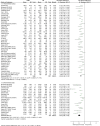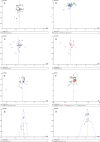Comparison of Deep Inspiration Breath Hold Versus Free Breathing in Radiotherapy for Left Sided Breast Cancer
- PMID: 35530354
- PMCID: PMC9069140
- DOI: 10.3389/fonc.2022.845037
Comparison of Deep Inspiration Breath Hold Versus Free Breathing in Radiotherapy for Left Sided Breast Cancer
Abstract
Objectives: Modern breast cancer techniques, such as the deep inspiration breath-hold (DIBH) technique has been applied for left-sided breast cancer. Whether the DIBH regimen is the optimal solution for left-sided breast cancer remains unclear. This meta-analysis aims to elucidate the differences of DIBH and free-breathing (FB) for patients receiving radiotherapy for left-sided breast cancer and provide a practical reference for clinical practice.
Methods: Relevant research available on PubMed, Embase, Cochrane Library, and the Web of Science published before November 30, 2021 was independently and systematically examined by two investigators. Data were extracted from eligible studies for assessing their qualities and calculating the standardized mean difference (SMD) and 95% confidence intervals (CIs) using Review Manager software 5.4 (RevMan 5.4).
Results: Forty-one studies with a total of 3599 left-sided breast cancer patients were included in the meta-analysis. Compared with FB, DIBH reduced heart dose (D mean, D max, V30, V10, V5), left anterior descending branch (LAD) dose (D mean, D max), ipsilateral lung dose (D mean, V20, V10, V5), and heart volume significantly. Lung volume increased greatly, and a statistically significant difference. For contralateral breast mean dose, DIBH has no obvious advantage over FB. The funnel plot suggested this study has no significant publication bias.
Conclusions: Although DIBH has no obvious advantage over FB in contralateral breast mean dose, it can significantly reduce heart dose, LAD dose, ipsilateral lung dose, and heart volume. Conversely, it can remarkably increase the ipsilateral lung volume. This study suggests that soon DIBH could be more widely utilized in clinical practice because of its excellent dosimetric performance.
Keywords: deep inspiration breath hold; free breathing; left sided breast cancer; meta-analysis; radiotherapy.
Copyright © 2022 Lu, Yang, Zhang, Teng, Yuan, Zhang, He, Tang, Pang, Han, Chen and Li.
Conflict of interest statement
The authors declare that the research was conducted in the absence of any commercial or financial relationships that could be construed as a potential conflict of interest.
Figures










Similar articles
-
Is the Deep Inspiration Breath-Hold Technique Superior to the Free Breathing Technique in Cardiac and Lung Sparing while Treating both Left-Sided Post-Mastectomy Chest Wall and Supraclavicular Regions?Case Rep Oncol. 2017 Jan 16;10(1):37-51. doi: 10.1159/000453607. eCollection 2017 Jan-Apr. Case Rep Oncol. 2017. PMID: 28203163 Free PMC article.
-
Meta-analysis of deep inspiration breath hold (DIBH) versus free breathing (FB) in postoperative radiotherapy for left-side breast cancer.Breast Cancer. 2020 Mar;27(2):299-307. doi: 10.1007/s12282-019-01023-9. Epub 2019 Nov 9. Breast Cancer. 2020. PMID: 31707586
-
Cardiac dose reduction using deep inspiratory breath hold (DIBH) in radiation treatment of left sided breast cancer patients with breast conservation surgery and modified radical mastectomy.J Med Imaging Radiat Sci. 2021 Mar;52(1):57-67. doi: 10.1016/j.jmir.2020.12.004. Epub 2021 Jan 26. J Med Imaging Radiat Sci. 2021. PMID: 33509700
-
Dosimetric comparison of deep-inspiration breath-hold and free-breathing treatment delivery techniques for left-sided breast cancer using 3D surface tracking.Med Dosim. 2019 Autumn;44(3):193-198. doi: 10.1016/j.meddos.2018.06.002. Epub 2018 Aug 3. Med Dosim. 2019. PMID: 30078605
-
Clinical benefits of deep inspiration breath-hold in postoperative radiotherapy for right-sided breast cancer: a meta-analysis.BMC Cancer. 2024 Oct 8;24(1):1238. doi: 10.1186/s12885-024-12992-2. BMC Cancer. 2024. PMID: 39379827 Free PMC article.
Cited by
-
A Prospective Study on the Use of Deep Inspiration Breath-Hold Technique in External Beam Radiotherapy for Breast Cancer.South Asian J Cancer. 2024 May 13;14(1):30-37. doi: 10.1055/s-0044-1786880. eCollection 2025 Jan. South Asian J Cancer. 2024. PMID: 40124149 Free PMC article.
-
Deep Inspiration Breath Hold in Left-Sided Breast Radiotherapy: A Balance Between Side Effects and Costs.JACC CardioOncol. 2024 Jul 2;6(4):514-525. doi: 10.1016/j.jaccao.2024.04.009. eCollection 2024 Aug. JACC CardioOncol. 2024. PMID: 39239337 Free PMC article.
-
Mean Heart Dose Prediction Using Parameters of Single-Slice Computed Tomography and Body Mass Index: Machine Learning Approach for Radiotherapy of Left-Sided Breast Cancer of Asian Patients.Curr Oncol. 2023 Aug 4;30(8):7412-7424. doi: 10.3390/curroncol30080537. Curr Oncol. 2023. PMID: 37623018 Free PMC article.
-
Reproducibility of chestwall and heart position using surface-guided versus RPM-guided DIBH radiotherapy for left breast cancer.J Appl Clin Med Phys. 2023 Jan;24(1):e13755. doi: 10.1002/acm2.13755. Epub 2022 Aug 22. J Appl Clin Med Phys. 2023. PMID: 35993318 Free PMC article.
-
Cardiorespiratory dose comparison among six radiotherapy regimens for patients with left-sided breast cancer.Sci Rep. 2023 Aug 16;13(1):13339. doi: 10.1038/s41598-023-40577-9. Sci Rep. 2023. PMID: 37587214 Free PMC article.
References
-
- Clarke M, Collins R, Darby S, Davies C, Elphinstone P, Evans V, et al. . Effects of Radiotherapy and of Differences in the Extent of Surgery for Early Breast Cancer on Local Recurrence and 15-Year Survival: An Overview of the Randomised Trials. Lancet (2005) 366(9503):2087–106. doi: 10.1016/s0140-6736(05)67887-7 - DOI - PubMed
LinkOut - more resources
Full Text Sources

